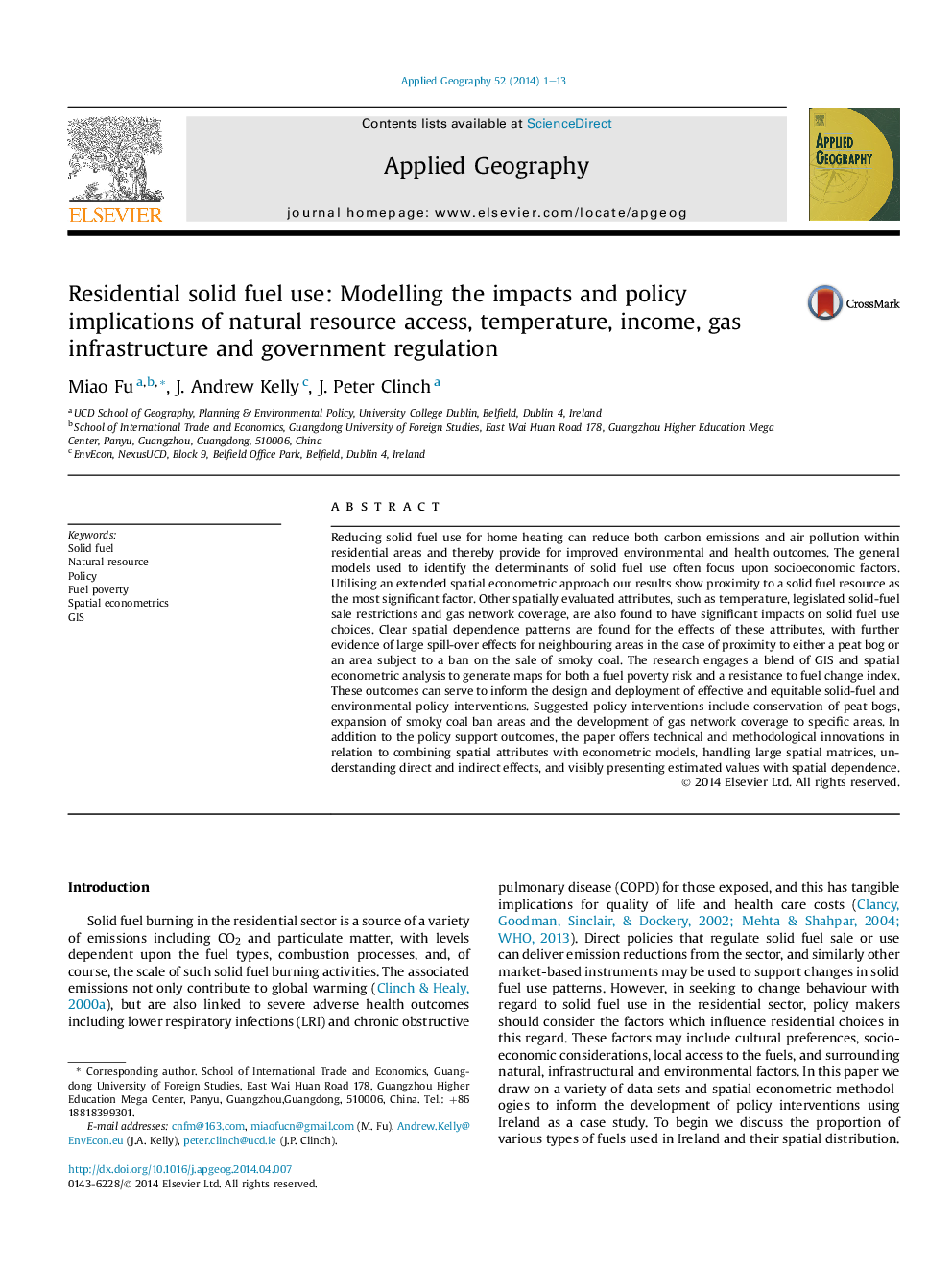| کد مقاله | کد نشریه | سال انتشار | مقاله انگلیسی | نسخه تمام متن |
|---|---|---|---|---|
| 6538746 | 158713 | 2014 | 13 صفحه PDF | دانلود رایگان |
عنوان انگلیسی مقاله ISI
Residential solid fuel use: Modelling the impacts and policy implications of natural resource access, temperature, income, gas infrastructure and government regulation
ترجمه فارسی عنوان
استفاده از سوخت جامد مسکونی: مدل سازی تاثیرات و پیامدهای سیاست دسترسی منابع طبیعی، دما، درآمد، زیرساخت های گاز و مقررات دولتی
دانلود مقاله + سفارش ترجمه
دانلود مقاله ISI انگلیسی
رایگان برای ایرانیان
کلمات کلیدی
ترجمه چکیده
کاهش مصرف سوخت جامد برای گرمایش خانگی می تواند هر دو میزان انتشار کربن و آلودگی هوا را در مناطق مسکونی کاهش دهد و از این طریق برای بهبود نتایج محیطی و بهداشتی فراهم می شود. مدل های کلی استفاده شده برای شناسایی عوامل تعیین کننده مصرف سوخت جامد اغلب بر عوامل اجتماعی-اقتصادی متمرکز می شوند. با استفاده از یک رویکرد اقتصادسنجی فضایی پیشرفته، نتایج ما نشان می دهد که مجذور یک منبع جامد سوخت به عنوان مهم ترین عامل است. دیگر ویژگی های ارزیابی فضایی، مانند درجه حرارت، محدودیت های فروش سوخت جامد و پوشش شبکه گاز، نیز تأثیر قابل توجهی در انتخاب گزینه های سوخت جامد پیدا می کنند. الگوهای وابستگی فضایی برای اثرات این خصوصیات، با شواهد بیشتری از اثرات ناشی از انبساط زیاد در مناطق همسایه در مورد نزدیکی به یک یا بدل توربو یا منطقه ای ممنوعه فروش ذغال سنگ دودی یافت می شود. این تحقیق ترکیبی از سیستم اطلاعات جغرافیایی و تجزیه و تحلیل مکانیزم مکانی برای تهیه نقشه برای هر دو ریسک فقر سوختی و مقاومت در برابر شاخص تغییر سوخت است. این نتایج می تواند به اطلاع رسانی بپردازد - طراحی و راه اندازی مداخلات سیاست گذاری جامع سوخت و محیط زیست موثر و عادلانه. مداخلات سیاستی پیشنهادی شامل حفظ بوته های ذغال سنگ، گسترش مناطق ممنوعه ذغال سنگ دمی و توسعه پوشش شبکه گاز به مناطق خاص است. علاوه بر نتایج حمایت از سیاست، این مقاله نوآوری های فنی و روش شناختی را در رابطه با ترکیب ویژگی های فضایی با مدل های اقتصادسنجی، برخورد با ماتریس های فضایی بزرگ، درک اثرات مستقیم و غیر مستقیم و همچنین ارائه ارزش های برآورد شده با وابستگی فضایی ارائه می دهد.
موضوعات مرتبط
علوم زیستی و بیوفناوری
علوم کشاورزی و بیولوژیک
جنگلداری
چکیده انگلیسی
Reducing solid fuel use for home heating can reduce both carbon emissions and air pollution within residential areas and thereby provide for improved environmental and health outcomes. The general models used to identify the determinants of solid fuel use often focus upon socioeconomic factors. Utilising an extended spatial econometric approach our results show proximity to a solid fuel resource as the most significant factor. Other spatially evaluated attributes, such as temperature, legislated solid-fuel sale restrictions and gas network coverage, are also found to have significant impacts on solid fuel use choices. Clear spatial dependence patterns are found for the effects of these attributes, with further evidence of large spill-over effects for neighbouring areas in the case of proximity to either a peat bog or an area subject to a ban on the sale of smoky coal. The research engages a blend of GIS and spatial econometric analysis to generate maps for both a fuel poverty risk and a resistance to fuel change index. These outcomes can serve to inform the design and deployment of effective and equitable solid-fuel and environmental policy interventions. Suggested policy interventions include conservation of peat bogs, expansion of smoky coal ban areas and the development of gas network coverage to specific areas. In addition to the policy support outcomes, the paper offers technical and methodological innovations in relation to combining spatial attributes with econometric models, handling large spatial matrices, understanding direct and indirect effects, and visibly presenting estimated values with spatial dependence.
ناشر
Database: Elsevier - ScienceDirect (ساینس دایرکت)
Journal: Applied Geography - Volume 52, August 2014, Pages 1-13
Journal: Applied Geography - Volume 52, August 2014, Pages 1-13
نویسندگان
Miao Fu, J. Andrew Kelly, J. Peter Clinch,
